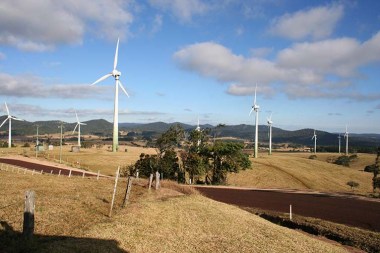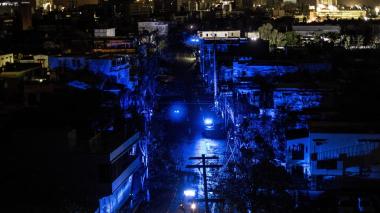Science and Technology:
¶ Anthropogenic climate warming could lead to temperatures of the water in some parts of the world exceeding the survival limits of their fish species, according to research from the University of Washington. Water temperatures in the tropical parts of the oceans are already nearing the upper temperature range for many fish living there. [CleanTechnica]
World:
¶ Conservative Chilean presidential candidate Sebastian Piñera, who leads in the polls for upcoming elections, pledged to move the country toward a fully renewable electricity grid by 2040. Piñera, who was Chile’s president from 2010 to 2014, would seek to build on investments his country has made in wind and solar energy. [Thomson Reuters Foundation]
¶ Defying the policy uncertainty that has held back utility-scale solar across most of the rest of Australia, renewables investment is gathering pace in Queensland, a region known as coal country. At a Townsville new-energy conference last week, attendees learned of 31 renewable projects under development in the state. [Corporate Knights Magazine]
¶ Victoria is one step closer to having its renewable energy target of 40% by 2025 written into law, after the Andrews government’s Renewable Energy Jobs and Investment Bill 2017 passed the lower house, despite a lack of backing of the state opposition. If passed, it will lock in the state in to successive targets of 25% by 2020, and 40% by 2025. [RenewEconomy]
¶ Siemens Gamesa Renewable Energy has secured a contract from Parque Eólico Arauco SAPEM to deliver 28 turbines for Phase III and IV of the Arauco wind complex. The project will generate a total of 97 MW through the G132-3.465MW turbines. The project is already being developed, and delivery is scheduled to be completed by Q2, 2018. [Power Technology]
¶ A district court ordered TEPCO to pay ¥376 million ($3.3 million) in compensation to evacuees of the Fukushima nuclear disaster but absolved the central government of responsibility. Forty-five people in 18 households who evacuated to Chiba Prefecture following the Fukushima Disaster sought a total of about ¥2.8 billion. [Asahi Shimbun]
US:
¶ The cities of San Francisco and Oakland have filed separate lawsuits against five of the largest oil companies in the world, public documents show. They are suing Chevron Corp, BP, ConocoPhillips, Exxon Mobil Corp, and Royal Dutch Shell, for the roles played by those companies in anthropogenic climate warming and rising sea levels. [CleanTechnica]

San Francisco (Photo: Cicerone, Wikimedia Commons)
¶ Georgetown University partnered with Origis Energy USA to build a solar power system to provide nearly 50% of the campus’s electricity by the 2019-20 academic year. Origis will install 105,000 solar panels on a 518-acre property in Maryland. The panels are expected to produce 75,000 MWh of power each year. [Georgetown University The Hoya]
¶ The Natural Resources Defense Council released an ambitious blueprint to dramatically increase energy efficiency, cut greenhouse gas pollution 80% from 1990 levels, raise wind and solar power generation to 70%, and usher in a clean energy future for the United States by 2050 – and it delivers benefits seven times the cost. [Windpower Engineering]
¶ The Virginia Citizens Consumer Council called on Dominion Energy to abandon its stalled plans to build a new nuclear reactor at its North Anna Power Station, the latest in a long-running campaign to convince the utility to shelve the expensive project for good. The group’s president called the reactor a “$19 billion or more white elephant.” [Roanoke Times]
¶ Next year, the electric utility in Banning, California, will get 77% of its power from renewable energy sources. Nuclear and hydro facilities, neither of which is counted as renewable in the state, will provide 15% of the power. Only 8% of the Banning Electric Utility’s electricity will come from grid sources that may include natural gas. [The Record Gazette]
¶ Facebook switched all electric accounts at its Menlo Park headquarters to Peninsula Clean Energy’s ECO100 option, making Facebook the largest participant in Peninsula Clean Energy’s 100% renewable energy option. PCE is San Mateo County’s electric supplier, formed as a Joint Powers Authority of all 20 cities in the county. [InMenlo]
¶ Hurricane Maria has dealt a new blow to Puerto Rico’s bankrupt electric company – causing widespread power outages and imposing costly repairs on a utility that was already struggling with more than $9 billion in debt, poor service and sky-high rates. Puerto Rico’s electric rates are already more than twice the national average. [Chicago Tribune]
¶ After President Trump’s policy reversals on clean energy and the environment, individual states have stepped up their focus on policies aimed at boosting carbon-free energy. According to S&P Global Market Intelligence, states have enacted 59 key energy-related policies through August 2017, with a clear trend toward clean energy. [Utility Dive]
¶ Federal authorities have subpoenaed documents from both companies that abandoned the VC Summer nuclear power construction project in South Carolina, the utilities confirmed, signaling the first concrete evidence of a federal probe into the failure. Both companies said they were cooperating fully with investigators. [Electric Light & Power]






